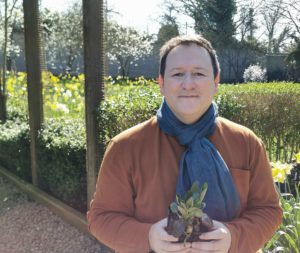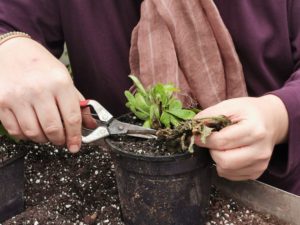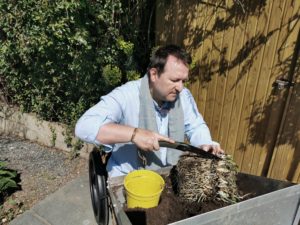Beth Otway’s Wildlife Gardening Tips
We don’t all need to possess large gardens to help wildlife, small spaces can form valuable refuges and habitats. Wildlife gardens are especially precious in our towns and cities, where space is at a premium.

Hedges
Instead of putting up a fence, could you plant a hedge? Hedges are more resilient and longer lasting than fences; they withstand stormy weather and provide food and shelter for wildlife. Hedges will enhance any style of garden, adding beauty to modern, traditional, and wildlife gardens. Hedging plants, like blackthorn, hornbeam, holly, hazel, and beech, can often be purchased as multiple plants in low-cost bundles and so can be very economical to buy.
Why not plant an edible hedge and grow your own fruit, nuts, berries, and edible flowers? You could grow your own elderflowers to produce your own home-grown and home-made elderflower cordial and if you’re feeling more adventurous, you could create your own elderflower champagne! Alternatively, leave the elderflowers to ripen to berries to produce your own elderberry wine, syrup, cordial, cassis, gin or jam.
There are many options when it comes to choosing plants for edible hedges, including:
- hazel or cobnuts (Corylus avellana)
- damsons (Prunus insititia)
- sloes (Prunus spinosa)
- plums and gages (Prunus domestica)
- elderflowers and elderberries (Sambucus nigra)
- blackberries (Rubus fruticosus)
- redcurrants (Ribes rubrum)
- gooseberries (Ribes uva-crispa)
- rose hips (Rosa)
- apples (Malus domestica)
- pears (Pyrus communis)
Look out for bare root plants, which can be ordered from nurseries and delivered during the autumn and winter months, while the plants are dormant.
Shaping your hedge
When trimming your hedge, only trim the top and sides. Allow your hedge to grow right down to ground level, so hedgehogs can nest and hibernate underneath. Avoid cutting hedges whilst birds are nesting – birds usually start nesting in late winter or early spring and their nesting season continues until September.

Planting trees in urban environments
If you’re planting a tree in an urban area where there are high levels of traffic, choose a tree that’s tolerant of pollution. Hornbean (Carpinus betulus) trees are especially useful as they survive in areas where pollution levels are high, making hornbeams the perfect choice of tree for an urban environment. Acer campestre, Alnus glutinosa, Corylus avellana ‘Aurea’, Mespilus germanica, and Taxus baccata are other tree options for city gardens.
Bare root plants
Bare root plants provide an environmentally friendly and economical way to purchase top quality plants including trees, roses, hedging, top and soft fruit plants, for gardens and allotments. These plants are field grown, so at the nursery they require far less water than plants grown in containers. Bare root plants can be grown, purchased, and delivered without using plastic, and because bare root plants are grown in the soil, these plants are usually peat-free.
There are so many benefits for gardeners who purchase bare root plants. I find that bare root pants tend to become established more readily than container grown plants. Customers ordering online, who are unable to inspect their plants will have no risk of purchasing a pot-bound plant, if they buy a field-grown, bare root plant.
Mycorrhizal fungi
Mycorrhizal fungi are UK species of fungi that occur naturally in the soil. These useful fungi form beneficial partnerships – symbiotic relationships with plants. Mycorrhizal fungi and plants effectively join forces in a lifelong alliance. The fungi attach themselves to the plant’s roots, creating a fast growing and extensive root system, that takes in a far greater quantity of nutrients and moisture than the plant could procure alone. This partnership greatly benefits plants, protecting and supporting plants through times of drought or stress.
You can purchase a concentrated amount of these beneficial, UK grown, mycorrhizal fungi at nurseries and garden centres. Mycorrhizal fungi are especially useful when you’re planting bare root plants, container-grown plants, or moving plants within your garden. A gel form of mycorrhizal fungi is available for bare root plants; whilst there are also selections of mycorrhizal fungi especially formulated for container grown plants, roses, bulbs, lawns, and other plants.
Butterflies
Nettles are food plants for caterpillars of a number of butterfly species, Comma, Peacock, Red Admiral, and Tortoiseshell butterfly caterpillars, all feed on nettles. Nettles are also an important food plant for the caterpillars of many moths. If you want to help butterflies and moths, nettles are well worth including in your garden!

Although it’s wise to grow stinging nettles in an out of the way area, so you can avoid stinging yourself; choose a sunny location, as butterflies lay their eggs on nettles growing in bright sunshine. I have planted a number of large containers with nettles in my garden, as planters are a good way to contain and manage these plants.
Nettles offer other benefits for gardeners; they attract ladybirds and can be used to a make home-made fertiliser. Nettles are edible and make delicious soups and teas.
Peat free compost
If you want to help nature and the environment, avoid using peat-based composts. Peat bogs are precious habitats that desperately need our protection. Peatlands cover just 3% of our planet’s surface but our peatlands hold more carbon than all the world’s forests; in fact, peatlands store more carbon than all our vegetive plants combined.
I’m a peat free gardener. Over the years, I’ve found that the majority of plants actually prefer peat-free compost. I even grow blueberries and Rhododendrons successfully in peat-free compost. I run Compost Trials to find top-quality peat-free composts (see my Compost Trials in full at https://www.pumpkinbeth.com/tag/compost-trial/).
Artificial turf
I’m deeply saddened to see how popular artificial turf has become. These artificial layers of plastic cover the ground, preventing birds and other wildlife from reaching the soil and foraging for insects.
If you’re looking for a low-maintenance solution for your garden, why not plant a flowering lawn, using naturally low growing plants like thyme (Thymus), daisies (Bellis perennis), clover (Trifolium), thrift (Armeria maritima), and birds foot trefoil (Lotus corniculatus)? These plants will flourish in a sunny or partially shaded site with well-drained soil.
If you’d prefer a green lawn, why not create a blissfully relaxing space using scented chamomile (Chamaemelum nobile)? Chamomile grows best in well-drained soils, in bright and sunny areas.
If your garden is shaded or damp underfoot, why not think about cultivating a smooth velvety carpet of moss?
Why not take part in No Mow May and leave areas of long grass for wildlife? Grasses are food plants for many insects, including butterflies and moths.
Bonfires
If you are planning to have a bonfire, the easiest and most wildlife friendly method is to gather your bonfire materials together in one go and light your bonfire immediately (or at least the same morning or afternoon).
If you have already gathered branches, leaves, and plant material, all set for having a bonfire another day, your bonfire stack might have appeared to be the perfect hibernating spot for hedgehogs and other wildlife. In this instance, it’s best to dismantle your bonfire and move all the materials you want to burn, checking for hedgehogs and wildlife as you go, and then light your bonfire in another spot. This will take extra time and effort, but it is worth it to know you haven’t killed a lovely hedgehog!
Hedgehogs
Hedgehogs need to be able to roam through a large area every night to source sufficient insects and food, to find a mate, and a safe place to nest. We can all help hedgehogs by ensuring that our gardens are connected. Make a passageway underneath a fence to allow hedgehogs to pass from your garden into your neighbour’s plot. Hedgehogs can’t manage steep slopes or steps, so cutting a hole at the base of the fence is often most effective solution. When adding a new fence, remember to always add a hedgehog passageway.
Hedgehogs are lactose intolerant. Please don’t ever give hedgehogs bread or milk – although hedgehogs relish the taste of bread and milk, they’re unable to digest this type of food – it makes them seriously ill. Instead, if you’d like to feed hedgehogs, leave out a meaty cat or dog food made with chicken or turkey, or complete cat biscuits. Look for cat or dog food without gravy, seeds, fruit, bread, dairy, fish, beef, or tripe, as these ingredients aren’t good for hedgehogs.
For more tips on sustainable gardening, visit my website: http://www.pumpkinbeth.com

























